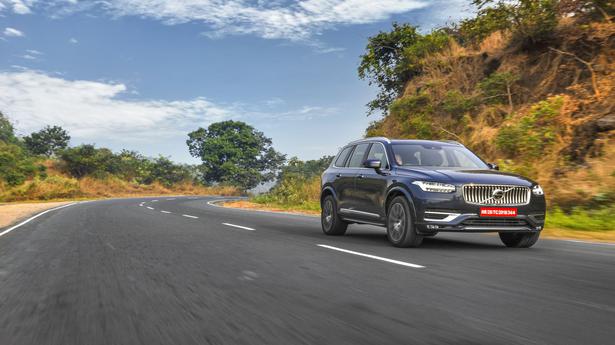
The ups and downs of the Volvo XC90 B6 petrol mild-hybrid
The Hindu
Here are a few reasons why we feel the car clicks design wise and performace wise
When it first arrived in 2015, the XC90 stood out for its clean-cut, forward-looking design, classy interior, and a bevy of attractive features. Now though, things are a bit different. The design has not evolved nor has it been updated sufficiently. The cabin, in ohis version, does not feel as lavishly appointed and the price has gone up too. What has changed is the engine, the old 2.0-litre diesel has been replaced by a new mild-hybrid petrol. But should this be enough to keep the XC90 on your shortlist? The easy answer is yes, and we list the reasons why. e
The XC90 B6 now gets a 2.0-litre, four-cylinder, petrol unit shared with other large Volvo cars and comes with power and torque figures that are impressive for a petrol engine of this capacity.
Known internally as the B420T, this engine makes a strong 300hp and 420Nm of torque. That is not as much as Audi’s facelifted Q7, which runs a larger V6 petrol engine and makes 340hp, or Merc’s GLE petrol that makes 367hp, but it is a lot of power for what is basically a 2.0-litre four-cylinder. So how does this engine do it?It uses three individual systems to boost performance — turbocharging, supercharging and an electric boost (from the hybrid system’s e-motor) to bump up power.
Initial responses as you put your foot on the accelerator are good. A combination of a 10kW electric boost from the hybrid system, and increased airflow from the crankshaft driven supercharger, helps the XC90 move off smartly. Put your foot down a bit harder and the Volvo even responds smartly with a strong tug. It does not quite have the grunt of a larger V6, but it certainly feels responsive and on the ball. And this is especially true when you engage the Dynamic drive mode from the screen; the mode selector ‘button’ that used to sit on the central console between the seats has been deleted.
What is great is that the Volvo engine even delivers a substantial kick when you mash the throttle. Do this and performance is strong, with 0-100kph coming up in a claimed 6.7 seconds. While the recently facelifted Audi Q7 is quicker by around a second, the Volvo delivers enough performance to keep things urgent and interesting.
The four-cylinder unit is not as seamless or smooth as a larger capacity motor. Probably down to the fact that it has to smoothen out responses from the turbo, supercharger and the electric motor, progression is not always as linear as you expect. Power delivery flattens out marginally at times or spikes. This is not in your face or troublesome, and you encounter it more in Dynamic mode, but pay attention or compare it to Merc’s smooth straight-six and you will feel the difference. In addition, spin the engine past 5,500rpm and it gets a bit vocal.
While Volvo has improved its 8-speed automatic, which is now smoother and more responsive, this is still a gearbox that doesn’t like to be hurried. Yes, for the most part, it will do your bidding, and with reasonable speed too, but drive it in a brisk manner and it often takes longer than you expect to deliver a downshift. At least, if it had paddle shifters behind the wheel, you could have better control when driving in a more relaxed manner.

 Run 3 Space | Play Space Running Game
Run 3 Space | Play Space Running Game
 Traffic Jam 3D | Online Racing Game
Traffic Jam 3D | Online Racing Game
 Duck Hunt | Play Old Classic Game
Duck Hunt | Play Old Classic Game

















